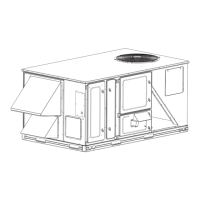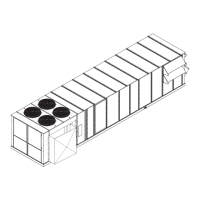28
COMP
COND COIL
HUMIDI-MIZER COIL
EVAP COIL
INDOOR ENTERING
AIR
OUTDOOR AIR
METERING
DEVICE
CLOSED VALVE
OPEN VALVE
3-WAY VALVE
RH1.x
RH2.x
C07124
Fig. 14 -- Hot Gas Reheat Mode (Reheat2) — Humidi--MiZert System
48/50PG20-- 28 and 48/50PM16--28
Reheat Control
The cooling staging and compressor control routines are
responsible for controlling each circuit in one of the three
sub-- modes (Cool, Reheat1, or Reheat2). When there is only a
cooling demand, one or more circuits will operate in normal
cooling mode. When there is only dehumidification demand, all
circuits will operate in Reheat2 mode. When there is both cooling
demand and dehumidification demand, all circuits will operate in
either Reheat1 or Reheat2 mode, with the portion of Reheat1
circuits determined from the cooling demand. The Requested
Reheat2 Stages (Operating Modes→COOL→HMZR→REQ.R)
shows the control’s request for reheat circuits if cooling is not
already requesting all stages. Available Reheat2 Stages (Operating
Modes→COOL→HMZR→AVL.R) displays circuits that are
available for reheat use. Actual Reheat2 Stages (Operating
Modes→COOL→HMZR→ACT.R) displays the current number
of circuits running in Reheat2 mode. These three status points
should only be monitored when there is only a dehumidification
demand, because their values can be forfeited to cooling stages
when cooling demand is present. Reheat2 Stage Incr. Time
(Configuration→HMZR →R.INC) and Reheat2 Stage Decr. Time
(Configuration→HMZR→R.DEC) set the time delay when
adding or subtracting a compressor for a reheat function. These
only apply when using adaptive thermostat or space sensor control.
There are three relay outputs that show reheat status. Cool -- >
Reheat1 Control (Outputs→COOL→CRC) show when the unit
has switch from pure cooling to reheat ready (based on a
dehumidification demand). Reheat2 Valve A
(Outputs→COOL→RH2.A) and Reheat2 Valve B,C
(Outputs→COOL→RH2.B) display when the respective circuit’s
Reheat2 valve is ener gized.
A circuit can be restricted from Reheat2 operation by the outside
temperature and saturated suction temperature. Reheat2 OAT
Limit A (Configuration→HMZR→RA.LO) and Reheat2 OAT
Limit B,C (Configuration→HMZR→RB.LO) set the lowest
outside temperature the respected circuit is allowed to run in
reheat2 mode. The lockout on/off status is shown as Reheat2 OAT
Loc
kout A (O
perating Modes→COOL→HMZR→R.LO.A)and
Reheat2 OAT Lockout B,C (Operating Modes→COOL→HMZR
→R.LO.B) for their respective circuit. If a circuit’s saturated
suction pressure falls below the low limit configuration during
Reheat2 operation, the circuit will switch to reheat1 (the circuits
Reheat2 valve will be turned off) for at least 2 minutes and until its
suction rises back above the high limit. Reheat2 SSP Lo Limit A
(Configuration→HMZR→RA.LP) and Reheat2 SSP Lo Limit
B,C (Configuration→HMZR→RB.LP) set the low pressure limit
for Reheat2 mode for individual circuits. Reheat2 SSP Hi Limit A
(Configuration→HMZR→RA.HP) and Reheat2 SSP Hi Limit B,
C(Configuration→HMZR→RB.HP) set the high pressure limit
for Reheat2 mode for each circuit.
Reheat Mode Diagnostic Help
The status of reheat mode sensor inputs may be viewed within the
display Inputs menu. The status of reheat mode outputs may be
viewed within the display Outputs or Run Status→COOL menus.
Additional diagnostic help, including status of circuit reheat
temperature limit lockouts may be viewed within the
Humidi-MiZer™ sub-menu of the cooling mode diagnostic table at
Operating Modes→COOL→HMZR.
The Service Test mode may be used to force the system to operate
in various stages of Reheat1 or Reheat2 mode, or to independently
operate the reheat valve control outputs. Fig. 15--19 show the
valve locations of Humidi--MiZer equipped units.
48/50PG and PM

